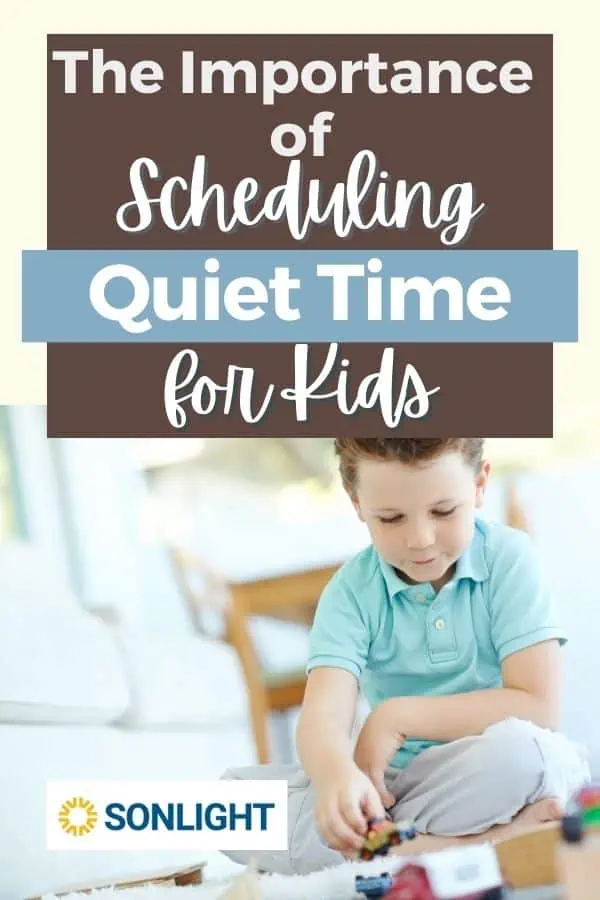The Importance of Scheduling Quiet Time for Kids
Published:
December 31, 2023

Contributor:
Sonlight
Disclosure: This post may contain affiliate links, meaning if you decide to make a purchase via my links, I may earn a commission at no additional cost to you. See my disclosure for more info.
There’s good news if you’re looking for a way to schedule in a mental break for yourself and the kids each day! A new quiet time routine might be just the thing that is missing from your homeschool. And it might become the best time of your day.
Quiet Time for Kids
We know that a daily routine is essential for kids to feel secure, orderly, and confident. So we schedule in the core subjects, the read alouds, the co-op and extracurricular activities, piano lessons, and more. Sometimes we’re not even home during the day because we’re so busy running from activity to activity! But are you missing out on the benefits of a daily quiet time?
What is Quiet Time?
Quiet time is simply a time away from others during the day when your child (and you!) can do a restful or quiet independent activity. It’s alone time with a purpose. This new routine might seem hard to implement at first if you’re kids aren’t used to playing alone, but it’s a good idea to let everyone recharge during the day. Your child’s bedroom is a great place for them to have quiet time so they’re less distracted from others in the house.
Why is quiet time important for kids?
A daily quiet time is a great way for everyone in the family to recharge. It’s not only important for young children, but your older kids will benefit from the mental break as well. Our brains can’t handle a constant influx of information without having time for processing. A quiet time allows your child the opportunity to reflect, process, and organize new information. An overload of stimulation is also harmful for children. A quiet time can help reduce stress and tension and nurture a more peaceful attitude. Check out our detailed list below of all the benefits of quiet time.
How long should quiet time be?
Once you decide to implement a daily quiet homeschool routine, you’ll definitely want to figure out how many minutes of quiet time you should use for your kids. The length of quiet time will differ depending on your child’s age. Here are some suggestions and best practices.
Quiet Time for Toddlers (1-3 years):
For little ones in the toddler stage, quiet time is crucial for their cognitive, emotional, and physical development. Aim for at least 1-2 hours of quiet time per day. This can be divided into shorter intervals throughout the day, such as two 30-minute sessions, or one longer stretch. Quiet activities like coloring, playing with puzzles, or reading books work well during this phase.
Quiet Time for Preschoolers (4-5 years):
Preschoolers still benefit greatly from quiet time, but their attention span may vary. Aim for 1-2 hours of quiet time, just like toddlers. Consider engaging them in activities that promote creativity and independent play, such as building blocks, imaginative play, or listening to audiobooks. Encourage them to explore their interests during this time, fostering a sense of independence.
Quiet Time for Elementary Students (6-11 years):
Quiet time remains important for grade-schoolers, but they may require less duration compared to younger children. Aim for 30 minutes to 1 hour of quiet time daily. This time can be used for reading, journaling, drawing, or engaging in a quiet hobby that interests them. Encourage them to choose activities that hone their creativity or allow them to unwind after a busy day of homeschooling.
Quiet Time for Preteens and Teens (12+ years):
As kids transition into their preteen and teenage years, they may have busier schedules and increasing academic demands. Nonetheless, setting aside some quiet time is still beneficial. Aim for at least 30 minutes to an hour, allowing them to relax, recharge, and reflect. This can involve reading, listening to music, practicing mindfulness exercises, or pursuing a hobby they enjoy.
Reasons to Schedule in quiet time for kids
When quiet time becomes a regular part of your day, you will notice some wonderful effects in your kids. Here are some of the benefits of quiet time.
Emotional Well-being
Kids can only handle so much stimulation, information, emotions, and interaction before they just crash. Giving kids a regular quiet time to look forward to will help them regulate their emotions so they can reset for the rest of the day.
Stress Reduction
Taking time to relax and recharge is helpful for stress reduction. Many children get overwhelmed with excessive noise and activity, and when you’re a homeschooling family with many children, you know that the house can get overwhelming! So it’s a gift to your kids to allow them some time away from the noise and chaos each day.
Imagination and Creativity
By giving your kids some quiet time with unstructured play, you’re able to help foster their imagination and creativity. Suddenly they need to figure out what to do and how to play independently from you and their siblings. When you give them space, their creativity can grow.
Concentration and Focus
A daily rest period is essential for children’s mental and cognitive growth and focus. Information overload is a real thing, and if you go nonstop during the day with school and activities, your children’s concentration and focus will wane. However, a daily quiet time will allow the brain time to synthesize and organize the new information from that day.
Problem-Solving Skills
Young kids may be initially bored when you implement a quiet time. But soon their creativity will help them and they’ll grow in their problem-solving abilities as they figure out what to do each day during quiet time.
Independence and Self-sufficiency
Independent play time is an essential part of growing our kids in self-sufficiency. Part of quiet time is fostering the ability of our kids to be independent from us and their siblings. Some children will have a harder time with this than others, but it’s a good learning lesson.
Self-awareness
When you’re along with yourself, you naturally start thinking and processing your emotions and feelings. Quiet time will allow your kids to be more self-aware and acknowledge those feelings rather than drown them out with noise and busyness.
Rest and Recharge
Add some comfy pillows to your quiet time space, and it becomes a wonderful opportunity to rest and recharge. Many kids don’t outgrow the need for naps just because they start doing kindergarten work! Some children naturally need more sleep and rest than others, and a daily quiet time is a great way to ensure that your kids are not getting overtired.
Sensory Processing
A dedicated time away from excessive stimulation is a great way to encourage sensory processing. Your children that are overwhelmed with too much noise and activity will greatly benefit from this time to manage sensory overload.
Patience and Delayed Gratification
Quiet time is an excellent way to learn patience and delayed gratification, especially at the younger ages. When children know they are expected to spend a certain amount of time in their room during quiet time, they’ll learn to figure out ways to spend that time while they wait for it to end. Younger children may need a visual timer to help them see how much time is left. It can be hard for young children without a concept of time to realize that a quiet time will not last forever!
Neurological Development
Quiet environments support children’s brain development. If their entire day is surrounded by noise and chaos, it’s hard for their brains to be able to function well and you’ll notice issues with concentration.
Self-discipline
Children will learn self-discipline through daily quiet time expectations. Discuss quiet time rules before you try to implement this new routine. Does everyone need to stay in their room? How will they know it’s done?
Emotional Regulation
Kids will benefit from emotional regulation during a daily quiet time. That is, this restful time alone during the day will help them learn how to manage boredom, process their emotional responses, and quiet their mind.
Enhanced Sleep Quality
A younger child will benefit from a brief afternoon nap to recharge and refresh. Scheduling a daily quiet time as part of a bedtime routine will improve your child’s sleep quality by helping them relax before sleep.
Respect for Others’ Boundaries
When you give your children the expectation of staying in their room during quiet time, you help to reinforce a respect for others’ boundaries. Everyone needs alone time, and everyone gets it uninterrupted.
Appreciation for Solitude
Children of all ages can benefit from an appreciation for solitude that grows out of a quiet time routine. It’s hard in this loud and busy world to learn to be quiet and enjoy the solitude. This habit will help them.
Improved Listening Skills
Children are able to listen better when they’ve had time to reflect on and organize their thoughts during a brief respite each day. Concentration is improved by a daily quiet time and so are listening skills.
Reflection and Gratitude
The extra time spent alone can help kids be able to reflect on what’s happening around them and find a place for gratitude. Encourage them to write in a gratitude journal daily to grow this habit.
Enhanced Academic Performance
When children’s brains have been able to process new information and rest for a short time each day, kids are ready for new learning adventures. Their brains are fresh, they’re able to concentrate and listen better, and you’ll start to see enhanced academic performance.
10 Quiet Time Activities
Here are 10 great ideas for quiet time activities.
1. Independent Reading
Grab a stack of books and let your kids enjoy time for independent reading. You can even add in some quiet read aloud activities as needed.
2. Puzzles and Brain Teasers
Create a quiet time bin that includes items like I Spy coloring pages, crossword puzzles, and preschool opposites puzzles to keep young and old alike busy with puzzles and brain teasers.
3. Arts and Crafts
Some simple arts and crafts activities make a fun quiet time activity for creative kids. Simple cut and paste activities can be fun for younger children. Older kids can work on handicrafts independently.
4. Building Blocks
Quiet play with open-ended toys like building blocks is the perfect quiet time activity for many ages.
5. Quiet Games
You can find quiet one-player games that are fun to use during quiet time. Even games like Bananagrams, meant for multiple players, can be used during quiet time very effectively!
6. Sensory Play
Quiet time spaces can be outfitted with items for sensory play. So pull out those sensory play bins for your younger kids, or give your older kids water beads or fidget toys.
7. Journaling or Drawing
Journaling for kids is a great activity for older kids during quiet time. Use these reading journal ideas to get you started. Or, simple drawing activities are fun for all ages.
8. Quiet Music Time
Rest time is a wonderful time to pull out some soothing music. Music is one of the best things to help you de-stress.
9: Audiobooks
Quiet time is the perfect time to listen to audio books. Make a list of your favorite audiobook recommendations and see how many your child can get through this year! You’ll be amazed.
10: Family-Friendly Podcasts
Family-friendly podcasts are another great idea for your older kids to listen to during quiet time. Podcasts are a fun way to be entertained or learn new information about a topic they love.
In Conclusion
Of course, a quiet time routine will not only benefit the kids, but it will also give you a much-needed break as a homeschool mom. There’s something magical when everyone retreats to their rooms for a short quiet time each afternoon. And with all the fun activities to implement a quiet time routine with your kids, each day can look different. Here’s to your quiet time success!








